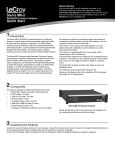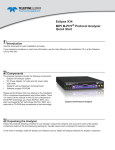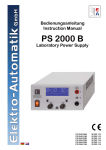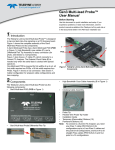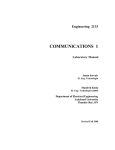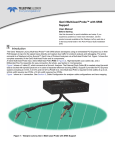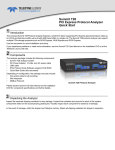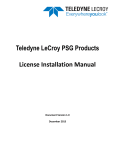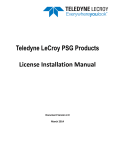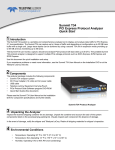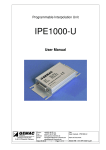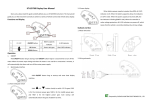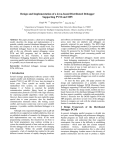Download M-PHY GEAR3 Multi-lead Probe User Manual
Transcript
M-PHY GEAR3 Multi-lead Probe Quick Start Guide / User Manual Before Starting Use this document for quick installation and setup. If you experience problems or need more information, see the product manuals available at the Teledyne LeCroy web site or in the Documents folder in the software installation DVD. 1 The M-PHY GEAR3 Teledyne LeCroy Multi-lead Probe™ allows developers using an embedded bus in their PCB designs to tap into the signal traces directly and capture bus traffic for protocol analysis and debugging. The probe connects to a Teledyne LeCroy Eclipse X34 Analyzer via a Multi-lead Probe Pod. Figure 1 shows the complete assembly of the M-PHY Gear3 Multi-lead Probe and its components. An M-PHY GEAR3 Multi-lead Probe has a GEAR3 Multi-lead POD (Pod in Figure 2), High Bandwidth coax cables (C), and a Differential Flex Tip Assembly for easy connection (for photo, see Section 2, Components). Figure 2 shows a straight cable (iPass), which connects to a Eclipse X34 Analyzer. Support is provided for M-PHY systems including GEAR1, GEAR2, and GEAR3 for both rate A and rate B. One Multi-lead Pod is required for link widths of up to x4. Figure 1 shows a x1 connection. See section 8, Cable Configuration for analyzer cable configurations and lane mapping. Figure 1. Teledyne LeCroy M-PHY GEAR3 Multi-lead Probe and Components 2 Components The Teledyne LeCroy M-PHY GEAR3 Multi-lead Probe has the following components: • M-PHY GEAR3 Multi-lead POD (Pod in Figure 2) • High Bandwidth Coax Cable Assembly (C in Fiugre 2) iPass Pod C E Figure 2. Teledyne LeCroy M-PHY GEAR3 Multi-lead POD and Components Upstream Clock To Analyzer Power Jack DC IN 12V Common Clock Reference Input (when using External Reference Clock for single clock applications also used as Downstream Clock Input) Upstream Clock Input Connectors for Coaxial Cables Downstream Clock • • Power Supply • High Bandwidth Coax Cable Assembly (C in Figure 1) • Gen3 Multi-lead Probe Differential Flex Tip Installation Guide Flexible Wire Tip Probe Holder Temporary (Removable) Stickers (10) Permanent Stickers (10) • • • Flexible Wire Probe Tip Holder Installation Guide Temporary (Removable) Stickers (10) • Permanent Stickers (10) Two Clocking Cable Assemblies such as the one shown below 3 Determining Sampling Points Installing a multi-lead probe system requires some advanced planning. Since the multi-lead probe system is designed for use with PCB designs that may not have been specifically laid out with probing in mind, probe points must be identified and selected to allow the protocol analyzer system to access the M-PHY bus contained within the board. Typical probe points might include exposed pins of components, or exposed traces or vias on the board along the M-PHY channel. For each bi-directional lane of a M-PHY bus, the probe tips need to make contact with four signals: Rx+, Rx-, Tx+ and Tx- to capture data traffic going in each direction. So for a x1 design, four signals must be sampled; for a x2, eight signals, and so on up to a x4 design which requires 16 individual sample points.The GEAR3 multi-lead probe tip is designed to sample two points in close proximity, either the Rx+ and Rx- differential pair, or the Tx+ and Tx- differential pair. So each bi-directional lane requires two probe tips (up to 8 probe tips for x4 designs). Rx- Rx+ Once possible probe locations are identified, the locations to be used must be selected considering the following criteria: 1. The probe locations must be within sufficient physical proximity to each other that the probe cables and probe tips can easily reach back to the probe pod, which gathers and amplifies the signals prior to passing them along to the analyzer. Each probe pod handles up to eight (8) probe tips. The probe pods are then connected back to the analyzer using 1 meter iPass cables using straight x4-to-x8 iPass cables for other cases). The dimensions of the probe components are as follows: • Probe Pod: 163 x 37 x 106 mm (6.4” x1.5” x 4.2”) • Probe Cable: 294 mm (11.6”) • Probe Tip: 71 mm (2.8”) 2. The probe locations should be selected to provide the best possible signal with minimum distortion along the M-PHY channel. As a general rule of thumb, this location is typically as near as possible to the Tx component pins (see illustration below). If an oscilloscope is available to make measurements, the probe requires the following minimum differential signal requirements at a given bit error rate at the analyzer probe point: • Inner eye width = 100ps Minimum (see 1 in the following figure) • Inner eye height = 60mVpp Minimum (see 2 in the following figure) • Maximum signal amplitude 350mVpp Maximum (see 3 in the following figure) • If measurements/simulations are not available, the optimal location is typically at the component transmitter output pins. Once probe points have been selected, you are now ready to prepare for installation of the M-PHY GEAR3 Multi-lead Probe. 1= 100ps ABCD 1 3= 350mVpp 2= 60mVpp Note: As an aid in calculating the differential impedance with probes installed, the probe impedance is (TBD)*. Note: (TBD)* Values not determined at time of document printing, for more information contact “Teledyne LeCroy Customer Support” on page xii (at the end of this document). 4 Preparing Probe Tips for Installation The first step in preparing for installation is to ensure that the probe tips are in good condition. If you are using new probe tips for the first time, examine the leads under magnification to ensure the leads are clean and secure, and then proceed to step 7. If the probe tips have been used previously, it may be necessary to clean the leads of excess solder or to remove and replace the leads. Small spool of wire is included with each probe tip to be used in replacing broken or damaged tip leads. To replace the tip leads, follow this procedure: 1. Using a soldering iron, heat the existing lead wire at the via where the lead enters the probe tip. Carefully remove the existing wire segment from the via. 2. Clean the via barrel of any excess solder. 3. Cut a new length of wire of approximately 2-3” from the wire spool supplied with the probe tip. 4. Thread the wire segment through the clean via located at the tip of the probe. 5. Heat with a soldering iron and apply small amounts of solder on the under-side of the tip at the via until the wire is secured within the via. 6. Trim the excess wire on the top of the probe tip as closely as possible to the surface of the probe tip. 7. Trim the lead wire on the underside of the probe tip to a maximum length of 2.5 mm (0.1”). 8. Repeat steps 1-7 with the other lead wire. 9. Trim the final lead lengths as short as possible to improve signal fidelity while allowing sufficient room to attach the leads to the signal test point and maintaining equal lengths of the two leads [to within 0.25 mm (0.01”) if possible to improve signal fidelity—use calipers to measure lead length]. 10. Trim the probe wire to a maximum length of 0.1 ± 0.01 inches. 5 Ground Wire Installation Systems with high ground noise may need an additional ground wire to a pad available near the tip of the probe. If greater than 50mV drop in common mode voltage, it is recommended that you install a ground wire. The ground wire shall be a minimum of 30AWG. Abundant solder is recommended to avoid ripping the pad off. It is recommended to keep the wire length shorter than 5in to minimize the ground loop. See figures below: Solder location on cable Wire lead attached to solder point Ground wire attached to cable 6 Installing the M-PHY Multi-lead Probe 1. Installing the M-PHY Multi-lead Probe requires following these steps: 2. At the site of each probe tip, install a support bracket, which is attached to the surface of the PCB using either a removable adhesive pad or a permanent adhesive pad (if the installation will be permanent or if additional support is desired). Slip the probe tip into the support bracket. The small bump on the probe tip head will click into place in the recess visible in the probe bracket. See illustrations below of a completed probe bracket installation. 3. Attach the probe tip leads, connecting each probe tip to the two differential sampling points for that signal. a. Use probe tip leads that are of equal length, and are not longer than 2.5 mm (0.1”).The Flex Tip is pre-installed with 0.1 inch long leads. It is recommended to trim the length of the tip as short as possible to improve signal fidelity margin at the analyzer. The two leads must be cut to the length of +/- 0.01 inches. b. Solder the leads to the appropriate sampling points using the minimum amount of solder necessary to maintain a secure connection. c. Once soldered, the probe tip should be angled at 30-45 degrees to the plane of the PCB under test, as shown in the figure to the right. d. Avoid placing the tip over any PCB components. 30 - 60 e. Position the flexible metal wire of the support bracket to hold the probe tip in place and at the desired angle to the PCB under test. 4. Once the probe tip has been installed properly in the support bracket and soldered to the sampling points on the PCB under test, the installed probe tip should look like the illustration below. 5. The probe cables should then be plugged into the probe pod(s), starting with the lowest left port as shown in the illustration at the right. See section 7 for information on how to connect the cables under different configurations. 6. Each probe tip should then be connected to the high bandwidth coax cable assembly by plugging the probe tip into the smaller end of the probe cable. Make sure you connect the soldered Lane 0 to the coaxial pair connected to Lane 0 in the pod and so on. 7. With the probe cables plugged into the Probe Pod, connect the Probe Pod to the protocol analyzer by using an iPass cable (see A below). Clock Connectors on the pod A iPass Cable B 8. Reference Clock Cables Reference clock cables are provided with each Probe Pod (see B above) to be used when recording bus traffic with an external clock. The external reference clock allows the analyzer to obtain lock more quickly when a link is returning from a low speed state. If the DUT does not supply a reference clock, the internal reference clock in the analyzer can be used instead, and the reference clock cables are not required. The selection of using the external reference clock or the internal analyzer clock is made in the Recording Options dialog of the analyzer software. If an external reference clock is required, connect the reference clock cable from the DUT to the Ref Clk In port on the Probe Pod. The reference clock cable is configured at one end to attach to a two-pin header on the DUT, and the other end has a connector that clips into the Ref Clk In port on the pod. 7 Differential Flex Tip Attaching the Tip to the Probing Point 1. The Flex Tip is pre-installed with 0.1 inch long leads. a. It is recommended to trim the length of the tip as short as possible to improve signal fidelity margin at the analyzer. The two leads must be cut to the length of +/- 0.01 inches. 2. Once soldered, the tip head must be angled at 30-60 degrees to the plane of printed circuit board. Refer to the following figure. a. Avoid placing the tip directly over any components. b. A tip holder, supplied with the probe, can be used to secure the tip assembly at the desired angle. Note: See section 4 for instructions on preparing probe tips for installation. 8 Cable Configuration Probe Cable Configuration for x1 to x4 Designs The x1 -x4 configuration uses 1 Pod. Connect the Probe tips to the Pod according to the following table: M-PHY designs that use x1 through x4 designs use one M-PHY GEAR3 Probe Pod. The probe cables are connected to the probe pod as shown in the table below: So for a x1 design, the two probe cables would be plugged into A0 and B0. For a x2 design, the four probe cables would be plugged into A0, B0, A1 and B1. For a x4 design, all eight ports on a single probe pod would be fully populated. The “A” and “B” designations refer to the routing of the signals through the iPass cable which is used in M-PHY designs up to x4 to connect the single probe pod to both the “Upstream” and “Downstream” ports of the analyzer. Normally the “A” cable is attached to the “Upstream” [or “Upstream (0-7)”] analyzer port, and the channels connected to the A0 through A3 ports will show up as the Upstream channels of Lanes 0-3, respectively. 9 Recording Traffic After the Eclipse X34 Analyzer and Multi-Lead Probe are properly setup, use the appropriate software to record traffic in the link. Follow the instructions in the user manual that came with your analyzer to install the software on the host CPU, which can be connected to the analyzer via a USB or Ethernet connection. In the Recording Options Dialog window, look for the "Reference Clock" section, and select "iPass" to use the external reference clock. Now the Record button can be pressed to start the recording of a trace. Teledyne LeCroy Customer Support Online Download Periodically check the Teledyne LeCroy Protocol Solutions Group web site for software updates and other support related to this product. Software updates are available to users with a current Maintenance Agreement. Mail: Web: E-mail: Tel: Tel: Fax: 3385 Scott Blvd., Santa Clara, CA 95054-3115 teledynelecroy.com/tm/Library/software/PSG [email protected] (800) 909-7112 (USA and Canada) (408) 653-1260 (worldwide) (408) 727-6622 (worldwide) Trademarks and Servicemarks Changes Teledyne LeCroy, PETracer, Summit T3-16, Summit T3-8 and Eclipse X34 are trademarks of Teledyne LeCroy, Inc. All other trademarks are property of their respective companies. Product specifications are subject to change without notice. Teledyne LeCroy reserves the right to revise the information in this document without notice or penalty. Copyright © 2014 by Teledyne LeCroy, Inc. All rights reserved. Part Number: 925237-00 Rev. B This document may be printed and reproduced without additional permission, but all copies should contain this copyright notice.












